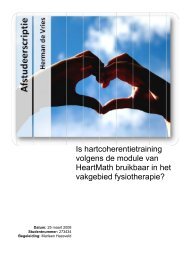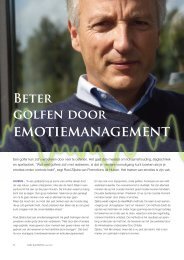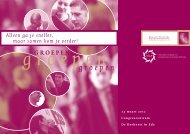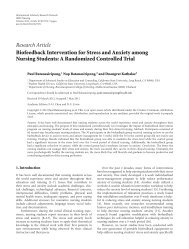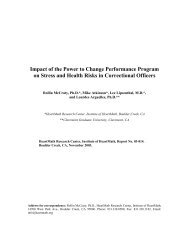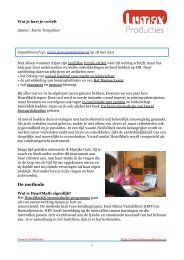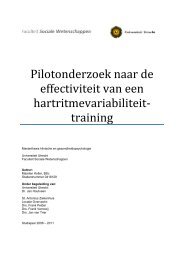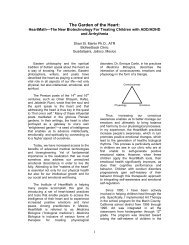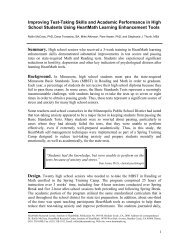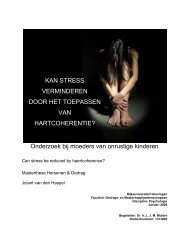Electrophysiological Evidence of Intuition - Heartmath Benelux
Electrophysiological Evidence of Intuition - Heartmath Benelux
Electrophysiological Evidence of Intuition - Heartmath Benelux
You also want an ePaper? Increase the reach of your titles
YUMPU automatically turns print PDFs into web optimized ePapers that Google loves.
THE JOURNAL OF ALTERNATIVE AND COMPLEMENTARY MEDICINE<br />
Volume 10, Number 1, 2004, pp. 133–143<br />
© Mary Ann Liebert, Inc.<br />
<strong>Electrophysiological</strong> <strong>Evidence</strong> <strong>of</strong> <strong>Intuition</strong>: Part 1.<br />
The Surprising Role <strong>of</strong> the Heart<br />
ROLLIN McCRATY, Ph.D., 1 MIKE ATKINSON, 1 and RAYMOND TREVOR BRADLEY, Ph.D. 2<br />
ABSTRACT<br />
Objectives: This study aims to contribute to a scientific understanding <strong>of</strong> intuition, a process by which information<br />
normally outside the range <strong>of</strong> conscious awareness is perceived by the psychophysiological systems.<br />
The first objective, presented in two empirical papers (Part 1 and Part 2), was to replicate and extend the results<br />
<strong>of</strong> previous experiments demonstrating that the body can respond to an emotionally arousing stimulus seconds<br />
before it is actually experienced. The second objective, to be presented in a third paper (Part 3), is to develop<br />
a theory that explains how the body receives and processes information involved in intuitive perception.<br />
Design: The study used a counterbalanced crossover design, in which 30 calm and 15 emotionally arousing<br />
pictures were presented to 26 participants under two experimental conditions: a baseline condition <strong>of</strong> normal<br />
psychophysiologic function and a condition <strong>of</strong> physiological coherence. Primary measures included: skin conductance;<br />
the electroencephalogram (EEG), from which cortical event-related potentials and heartbeat-evoked<br />
potentials were derived; and the electrocardiogram (ECG), from which cardiac decelerations/accelerations were<br />
derived. These measures were used to investigate where and when in the brain and body intuitive information<br />
is processed.<br />
Results: The study’s results are presented in two parts. The main findings in relation to the heart’s role in<br />
intuitive perception presented here are: (1) surprisingly, the heart appears to receive and respond to intuitive<br />
information; (2) a significantly greater heart rate deceleration occurred prior to future emotional stimuli compared<br />
to calm stimuli; (3) there were significant gender differences in the processing <strong>of</strong> prestimulus information.<br />
Part 2 will present results indicating where in the brain intuitive information is processed and data showing<br />
that prestimulus information from the heart is communicated to the brain. It also presents evidence that<br />
females are more attuned to intuitive information from the heart.<br />
Conclusions: Overall, we have independently replicated and extended previous research documenting prestimulus<br />
responses. It appears that the heart is involved in the processing and decoding <strong>of</strong> intuitive information.<br />
Once the prestimulus information is received in the psychophysiologic systems, it appears to be processed<br />
in the same way as conventional sensory input. This study presents compelling evidence that the body’s perceptual<br />
apparatus is continuously scanning the future. To account for the results presented in Parts 1 and 2,<br />
Part 3 will develop a theory based on holographic principles explaining how intuitive perception accesses a<br />
field <strong>of</strong> energy into which information about future events is spectrally enfolded.<br />
INTRODUCTION<br />
Most people at some time have experienced “intuitive”<br />
perceptions about distant objects or future events that<br />
later turned out to be correct. In many cases, these perceptions<br />
are really cognitive inferences, extrapolations based on<br />
forgotten memories <strong>of</strong> prior experience that seep into consciousness<br />
(Sarbin et al., 1960). However, there are instances<br />
1 HeartMath Research Center, Institute <strong>of</strong> HeartMath, Boulder Creek, CA.<br />
2 Institute for Whole Social Science, Carmel, CA.<br />
133
134<br />
when so-called “gut feelings” or “intuitive insights” are<br />
found to be valid and related to circumstances so unique that<br />
these intuitions do not seem explicable on the basis <strong>of</strong> prior<br />
experience. It is postulated that such intuitive perception involves<br />
connection to a field <strong>of</strong> information beyond normal<br />
conscious awareness (Loye, 1983).<br />
The Concise Oxford Dictionary (1964) defines intuition<br />
as “immediate apprehension by the mind without reasoning,<br />
immediate apprehension by a sense, and immediate insight.”<br />
* Roberto Assagioli (1971) observes that intuition is<br />
“a synthetic function in the sense that it apprehends the totality<br />
<strong>of</strong> a given situation or psychological reality. It does<br />
not work from the part to the whole—but apprehends a totality<br />
directly in its living existence.” In these terms, intuition<br />
is defined as a process by which information normally<br />
outside the range <strong>of</strong> cognitive processes is immediately<br />
sensed and perceived in the body and mind as certainty <strong>of</strong><br />
knowledge or feeling about the totality <strong>of</strong> a thing distant or<br />
yet to happen. The “thing” can be an object, entity, or event<br />
in the material world, or an intellectual construct, such as a<br />
thought or idea. Often the feeling <strong>of</strong> certainty is absolute—<br />
the intuition is experienced as beyond question or doubt—<br />
and the feeling can encompass positive emotions, such as<br />
optimism and excitement, or negative emotions such as<br />
dread, fear, or terror. This experience <strong>of</strong> an immediate, total<br />
sense <strong>of</strong> the thing as a whole is quite unlike the informational<br />
processing experience <strong>of</strong> normal awareness. In normal<br />
awareness, the contents <strong>of</strong> the mind are updated<br />
incrementally, as the moment-by-moment sequences <strong>of</strong> sensory<br />
experience unfold.<br />
Within this context, our study investigated the temporal<br />
dimension <strong>of</strong> intuition: the proposition that the body’s psychophysiologic<br />
systems receive and process information<br />
about a future event before the event actually happens. We<br />
present compelling electrophysiological evidence that shows,<br />
under controlled experimental conditions, that both the brain<br />
and the heart process information about the emotionality <strong>of</strong><br />
a stimulus before this stimulus is presented to research participants.<br />
Although ours is among the latest in a long line <strong>of</strong> studies<br />
that document phenomena involving perception <strong>of</strong> future<br />
information (see below), most scientists regard such<br />
findings as anomalous. Even among those who study it, intuitive<br />
perception is viewed largely as the result <strong>of</strong> past experience.<br />
Thus, most recent work sees intuition as a function<br />
<strong>of</strong> the unconscious mind accessing existing information<br />
within the brain from forgotten experience (Agor, 1984;<br />
Eisenhardt and Zbaracki, 1992; Hogarth, 2001; Laughlin,<br />
1997; Myers, 2002; Torff and Sternberg, 2001).<br />
* As defined here, intuition may appear similar to the concept <strong>of</strong><br />
precognition: “a form <strong>of</strong> extrasensory perception involving foreknowledge<br />
<strong>of</strong> a future event” (McGraw-Hill Dictionary <strong>of</strong> Scientific<br />
and Technical Terms, 1994). However, in light <strong>of</strong> our empirical<br />
results, we develop a distinction between these two concepts<br />
in Part 2.<br />
MCCRATY ET AL.<br />
This viewpoint stems from the common assumption in<br />
neuropsychology that conscious awareness, memory, and<br />
unconscious perception are emergent properties <strong>of</strong> the brain<br />
and nervous system alone. It is believed that the mind is<br />
emergent from the brain, and therefore subject to the same<br />
physical constraints as all biologic systems, in which time<br />
is believed to flow from the past to the future. From this<br />
perspective, awareness is thought to be restricted to perceptions<br />
<strong>of</strong> present sensory input, intermingled with memories<br />
<strong>of</strong> the past.<br />
The dilemma over intuition (whether it is based on memory<br />
<strong>of</strong> past experiences or involves actual perception <strong>of</strong> some<br />
thing apart in space or ahead in time) is comparable, in many<br />
respects, to the dilemma <strong>of</strong> physics in the early twentieth<br />
century. A number <strong>of</strong> now famous “anomalous” experiments<br />
in quantum physics repeatedly demonstrated that the subatomic<br />
world is a domain in which there is virtually instantaneous<br />
“communication” <strong>of</strong> information between particles<br />
separated by vast regions <strong>of</strong> space, and in which particles<br />
act is if they have “knowledge” <strong>of</strong> events before these events<br />
actually happen. Although this defied explanation by classical<br />
physics, these phenomena <strong>of</strong> nonlocal communication<br />
are now accepted as established scientific fact (Aczel, 2002;<br />
Nadeau and Kafatos, 1999; Penrose, 1989), and have led to<br />
the revolutionary understanding that such space/time-defying<br />
communication <strong>of</strong> information is the result <strong>of</strong> the inherently<br />
interconnected nature <strong>of</strong> the quantum world<br />
(Bekenstein, 2003; Bohm and Hiley, 1993; Nadeau and<br />
Kafatos, 1999).<br />
In the same way that nonlocal communication was once<br />
regarded as anomalous in physics, evidence <strong>of</strong> intuition to<br />
this point has been largely marginalized by science. Yet, in<br />
our view, the rigorous investigation <strong>of</strong> this phenomenon has<br />
potential to yield a fundamental shift in scientific understanding—even<br />
transforming the way we view ourselves in<br />
relation to the world. Thus, this study aims to contribute to<br />
the development <strong>of</strong> a scientific explanation for intuition, in<br />
an effort to enlarge scientific understanding <strong>of</strong> human perception:<br />
<strong>of</strong> how the body receives and processes information<br />
about objects or events distant in space or ahead in time.<br />
Central to this endeavor is the description <strong>of</strong> how information<br />
about future events is communicated to and processed<br />
by the sensory perception system.<br />
For the purposes <strong>of</strong> presentation, this work has been divided<br />
into three publications. The first two publications are<br />
empirical and describe an experiment conducted to determine<br />
where and when in the body information about a future<br />
event is registered and processed. This experiment was<br />
designed to replicate and extend the results <strong>of</strong> previous electrophysiological<br />
studies <strong>of</strong> the prestimulus response by<br />
adding measures <strong>of</strong> brain and heart activity well suited to<br />
investigate information processing. Part 1, presented here,<br />
reports results on skin conductance and heart rate decelerations/accelerations.<br />
Part 2, to be published in the next issue<br />
<strong>of</strong> this Journal, reports results on measures <strong>of</strong> brain activ-
ELECTROPHYSIOLOGICAL EVIDENCE OF INTUITION 135<br />
ity and on the interaction between the heart and brain in processing<br />
information about a future stimulus. Part 3, a forthcoming<br />
work, develops a theory to explain intuitive perception.<br />
This theory draws on the principles <strong>of</strong> holographic<br />
organization to describe how the body is connected, via sensory<br />
perception, to a field <strong>of</strong> energy that spectrally enfolds<br />
information about future events.<br />
Previous research<br />
The notion that intuitive perception is purely a function<br />
<strong>of</strong> the unconscious mind accessing forgotten prior experience<br />
has been challenged by several recent studies. Using<br />
rigorous experimental protocols, these studies have shown<br />
that the body <strong>of</strong>ten responds to a future emotionally arousing<br />
stimulus 4 to 7 seconds prior to experiencing the stimulus<br />
(Bierman, 2000; Radin, 1997b, 2003; Spottiswoode and<br />
May, 2003).<br />
A number <strong>of</strong> studies examining the brain’s prestimulus<br />
response (to be reviewed in Part 2) have demonstrated<br />
significant differences in event-related potentials † before<br />
presentation <strong>of</strong> the target stimuli compared to nontarget<br />
stimuli (Don et al., 1998; McDonough et al., 2002; Warren<br />
et al., 1992a, 1992b). Recently, researchers have also explored<br />
physiologic predictors <strong>of</strong> future events by investigating<br />
whether the human autonomic nervous system can<br />
unconsciously respond to randomly selected future emotional<br />
stimuli. Radin (1997a, 1997b) designed experiments<br />
to evoke an emotional response using randomly selected<br />
emotionally arousing or calming photographs. ‡ Indicators <strong>of</strong><br />
autonomic activity included skin conductance level (SCL)<br />
and photoplethysmographic measures <strong>of</strong> heart rate and blood<br />
volume. Comparison <strong>of</strong> SCL response between emotional<br />
and calm trials showed a significantly greater change in electrodermal<br />
activity approximately 5 seconds before a future<br />
emotional picture than before a future calm picture. These<br />
results have since been replicated (Bierman and Radin,<br />
1997; Bierman, 2000; Bierman and Scholte, 2002; Radin,<br />
2003). § A further study, using a free-running protocol, also<br />
found significant skin conductance changes in the pre-stimulus<br />
period (Spottiswoode and May, 2003).<br />
† Event-related potentials are voltage fluctuations that are associated<br />
in time with some physical, mental, or emotional occurrence.<br />
These potentials can be recorded from the scalp and extracted from<br />
the ongoing EEG by means <strong>of</strong> filtering and signal averaging.<br />
‡ The research subjects were instructed to press a computer<br />
mouse button to begin each trial. After the button-press the computer<br />
screen remains blank for 5 seconds, and then an image randomly<br />
selected from one <strong>of</strong> the two picture sets is shown for 3 seconds.<br />
This is followed by a blank screen for 10 seconds. At the<br />
end <strong>of</strong> this period, a message appears on the screen stating that<br />
when ready, the participant can press the mouse button to begin<br />
the next trial.<br />
§ Bem DJ. Precognitive habituation: Replicable evidence for a<br />
process <strong>of</strong> anomalous cognition. Unpublished manuscript, 2003.<br />
The participants did not press a button and were completely unaware<br />
<strong>of</strong> when an audio startle stimulus would be randomly presented.<br />
Operationally, an important implication <strong>of</strong> these studies’<br />
findings, for our research purpose, is that the prestimulus response<br />
to a future event is related to the degree <strong>of</strong> emotionality<br />
<strong>of</strong> that event. In short, we can hypothesize that the<br />
greater the emotional significance <strong>of</strong> a future stimulus, the<br />
larger will be the physiologic response prior to experiencing<br />
the stimulus.<br />
RESEARCH DESIGN AND METHODS<br />
We adopted Radin’s (1997b) basic experimental protocol<br />
while including additional measures <strong>of</strong> brain and heart activity<br />
well suited to investigate information processing. This<br />
was done to determine where and when in the brain and<br />
body information about the future event was registered and<br />
processed. In addition to SCL, we included the electrocardiogram<br />
(ECG) for heart rate variability (beat-to-beat decelerations/accelerations)<br />
measurement. A 19-channel electroencephalogram<br />
(EEG) for cortical event-related potential<br />
and heartbeat-evoked potential measurements was also included;<br />
details <strong>of</strong> these measurements and results will be<br />
provided in Part 2. These measures have all been used to index<br />
specific aspects <strong>of</strong> sensory information processing, and<br />
can be interpreted according to well-established operational<br />
criteria (see Discussion).<br />
This study utilized a counterbalanced crossover design<br />
with two experimental conditions. Each research subject<br />
participated in the protocol twice: once in his/her baseline<br />
psychophysiological state (condition 1), and once after having<br />
maintained a physiologically coherent state for 15 minutes<br />
prior to participation in the session (condition 2) (Fig.<br />
1). The post-physiological coherence condition was included<br />
to test the hypothesis that an enhanced prestimulus response<br />
is related to the maintenance <strong>of</strong> a state <strong>of</strong> physiological coherence.<br />
We previously introduced the term physiological coherence<br />
in documenting a physiologic mode frequently associated<br />
with sustained positive emotions. This mode encompasses<br />
distinct but related physiologic phenomena<br />
including entrainment, resonance, and synchronization,<br />
which reflect more efficient and harmonious interactions<br />
among the body’s subsystems (McCraty and Childre, 2002,<br />
2004; Tiller et al., 1996). Correlates <strong>of</strong> physiologic coherence<br />
include: increased synchronization between the two<br />
branches <strong>of</strong> the autonomic nervous system, a shift in autonomic<br />
balance toward increased parasympathetic activity,<br />
increased heart–brain synchronization, increased vascular<br />
resonance, and entrainment between diverse physiologic<br />
The counterbalanced design was necessary to control for exposure<br />
effects. Half the participants completed the experimental<br />
protocol in condition 1 first, whereas the other half completed the<br />
protocol in condition 2 first.
136<br />
oscillatory systems. The coherent mode is reflected by a<br />
smooth, sine wave-like pattern in the heart rhythms and a<br />
narrow-band, high-amplitude peak in the low frequency<br />
range <strong>of</strong> the heart rate variability power spectrum, at a frequency<br />
<strong>of</strong> about 0.1 Hz (Tiller et al., 1996).<br />
We have previously found that increased heart rhythm<br />
coherence correlates with significant improvements in performance<br />
on tasks requiring attentional focus and subtle discrimination<br />
(McCraty, 2002; McCraty and Atkinson, 2003),<br />
which may be important elements <strong>of</strong> the intuitive effect studied<br />
here.<br />
Participants<br />
Twenty-six (26) adult participants, 11 males, 15 females,<br />
ranging in ages from 28–56 (mean age, 45), were recruited<br />
from e-mail notices to people who had prior training in the<br />
HeartMath emotional management techniques, which facilitate<br />
the self-generation and maintenance <strong>of</strong> the physiological<br />
coherence mode (McCraty and Childre, 2002). Participants<br />
were in good health and had normal or correctedto-normal<br />
vision. All participants gave informed consent.<br />
Testing procedure<br />
FIG. 1.<br />
Research design.<br />
The two testing sessions were scheduled 2 weeks apart,<br />
with the order <strong>of</strong> the two experimental conditions randomly<br />
assigned for each participant. To test participants in their<br />
baseline psychophysiologic mode (condition 1), they were<br />
instructed not to engage in any meditative practices or practice<br />
<strong>of</strong> the HeartMath techniques on the testing day. To test<br />
participants in the physiological coherence mode (condition<br />
2), participants practiced the Heart Lock-In emotional restructuring<br />
technique for 15 minutes before beginning the<br />
session. The Heart Lock-In technique, which combines intentional<br />
heart focus with the self-generation <strong>of</strong> a genuine<br />
positive emotion, such as appreciation or care, has been previously<br />
shown to induce development and maintenance <strong>of</strong><br />
the physiological coherence mode (for details <strong>of</strong> this technique,<br />
see Childre and Martin, 1999; McCraty and Childre,<br />
2002).<br />
In the experimental sessions, each participant was seated<br />
in a comfortable chair in a sound-attenuated testing room,<br />
temperature-regulated to approximately 72°F. A video monitor<br />
was located approximately 1 meter in front <strong>of</strong> the participant<br />
at eye level, and a computer mouse was attached to<br />
MCCRATY ET AL.<br />
the arm <strong>of</strong> the chair for the participant to click when ready<br />
to initiate each trial.<br />
To record SCL, surface silver–silver chloride electrodes<br />
were attached to the pads <strong>of</strong> the participant’s nondominant<br />
hand on the index and second fingers. An isotonic skin conductance<br />
electrode gel was used to improve electrical contact.<br />
The signal was amplified by a Grass model 7P122G<br />
DC amplifier (Grass, West Warwick, RI).<br />
The ECG was measured using a lead-one configuration.<br />
A Grass model 7P6C ECG amplifier was used to detect the<br />
signals. A photoplethysmographic sensor was attached to the<br />
left earlobe to determine when the blood pressure wave<br />
reached the brain.<br />
Each participant was fitted with an electrode cap for<br />
recording <strong>of</strong> the EEG (details will be presented in Part 2).<br />
Respiration was also measured with a respiration belt placed<br />
around the chest.<br />
Stimulus presentation was controlled by a program written<br />
by David J<strong>of</strong>fe in Micros<strong>of</strong>t Visual C 5.0 (Micros<strong>of</strong>t Corporation,<br />
Redmond, WA). The stimulus control program generated<br />
a TTL pulse on one <strong>of</strong> the parallel port channels each<br />
time the participant pressed the mouse button to initiate the<br />
subsequent trial, and a second TTL pulse on a separate parallel<br />
port channel at the exact moment the stimulus image was<br />
presented on the video screen. The TTL timing signals were<br />
continuously collected throughout the session together with<br />
the physiologic data using a Data Translations DT3016 32-<br />
channel, 16-bit data acquisition board (Data Translation, Inc.,<br />
Marboro, MA) and Capital Equipment Corp. TestPoint version<br />
3.4a s<strong>of</strong>tware (Capital Equipment Corp., Billerica, MA).<br />
Data acquisition occurred at a rate <strong>of</strong> 256 samples per second.<br />
Participants were told that they were participating in a<br />
study to test their response to different types <strong>of</strong> emotionally<br />
stimulating photographs, and were unaware <strong>of</strong> the study’s<br />
true purpose. They were instructed to press the mouse button<br />
when ready to begin each trial. After “button press,” the<br />
monitor remained blank for 6 seconds, after which the computer<br />
randomly selected a photo and displayed it for 3 seconds<br />
(as illustrated in Fig. 2). A blank screen followed for<br />
10 seconds. After this cool-down period, a message appeared<br />
on the monitor, instructing participants to begin the next trial<br />
when ready. At the beginning <strong>of</strong> each experimental session,<br />
the stimulus control s<strong>of</strong>tware’s pseudorandom number generator<br />
was reseeded with the subject’s number followed by<br />
the current date as a six-digit number.<br />
After a demonstration trial to familiarize the participant<br />
with the process, the experimenter left the room. Each participant<br />
viewed 45 pictures in each <strong>of</strong> the two sessions; each<br />
session consisted <strong>of</strong> 30 calm pictures and 15 emotional pictures<br />
selected from the International Affective Picture System<br />
(IAPS). This 2:1 ratio was used to avoid physiologic<br />
habituation to the emotional pictures (Boucsein, 1992). #<br />
# Radin DI. <strong>Evidence</strong> for an anomalous anticipatory effect in the<br />
autonomic nervous system. Unpublished manuscript, 2002.
ELECTROPHYSIOLOGICAL EVIDENCE OF INTUITION 137<br />
records: a computer algorithm eliminated intervals that varied<br />
by more than 30% <strong>of</strong> the mean <strong>of</strong> the previous four intervals,<br />
and any remaining artifacts were removed during<br />
second-stage editing by an experienced technician who visually<br />
inspected the records. A regularly spaced time series<br />
was derived from the succession <strong>of</strong> normal RR intervals by<br />
linear interpolation <strong>of</strong> the irregularly spaced series and then<br />
resampled at 8 samples per second.<br />
FIG. 2.<br />
Data from a total <strong>of</strong> 2340 trials were collected across the<br />
two sessions for all participants.<br />
Stimulus photos were selected based on ratings <strong>of</strong> arousal<br />
level determined by the IAPS. Calm pictures were randomly<br />
selected from a pool <strong>of</strong> 60 images with the lowest arousal<br />
ratings; these included landscapes, seascapes, fruit, trees, animals,<br />
and common household objects. Emotional pictures<br />
were randomly selected from a pool <strong>of</strong> 30 images with the<br />
highest arousal ratings; these portrayed a range <strong>of</strong> erotic, violent,<br />
and emotionally stimulating subjects. All pictures<br />
were digitally displayed in color, at 600 800 screen resolution,<br />
on a 17-inch monitor. If, during a session, a given<br />
picture was randomly selected twice, another picture <strong>of</strong> similar<br />
emotionality was selected in its place; thus, no photos<br />
were repeated within a session.<br />
Data and statistical analysis<br />
Experimental protocol.<br />
Data editing was blind to stimulus category (calm or emotional<br />
targets). Data processing and statistical analysis used<br />
DADISP 4.1 (DSP Development Corp., Newton, MA),<br />
MATLAB 6.1 (The MathWorks, Inc., Natick, MA), and<br />
SPSS 8.0 (SPSS, Inc., Chicago, IL) s<strong>of</strong>tware.<br />
Skin conductance measures. To reduce the data generated<br />
by sampling at 256 samples per second, the low-frequency<br />
skin conductance channel was resampled at 8<br />
samples per second. Because measurement focused on<br />
how the physiology changed from the moment a given<br />
trial was initiated, each sample in each trial was transformed<br />
into a percentage difference score relative to the<br />
baseline SCL value at the moment the participant pressed<br />
the button to initiate the given trial (“button press”). To<br />
compute the percentage difference score (D), the first data<br />
point in each trial was subtracted from each <strong>of</strong> the 152<br />
points (19 seconds 8 samples per seconds) in the series.<br />
Then each point in the series was divided by the<br />
original value <strong>of</strong> the first data point <strong>of</strong> the series to yield<br />
the percentage difference series, in which the first point<br />
is always zero.<br />
Heart rate variability. The ECG data used for heart rate<br />
variability (HRV) analysis were all normal sinus intervals.<br />
All aberrant beats and artifacts were removed from the<br />
Statistics for SCL and HRV. To reduce the possibility <strong>of</strong><br />
false-positive findings, a deliberate decision was made to<br />
use statistically conservative procedures for data analysis.<br />
Therefore, randomized permutation analysis (RPA) was<br />
used to determine statistical significance <strong>of</strong> the differences<br />
between emotional and calm curves during the prestimulus<br />
period, because it controls for autocorrelations inherent to<br />
physiologic signals and their underlying non-normal distributions<br />
(Blair and Karniski, 1993). Applied separately to<br />
each individual’s SCL and HRV data, RPA generates two<br />
standard deviates, or z scores, per person: zpre, the differential<br />
prestimulus value, and zpost, the differential poststimulus<br />
value (Good, 1994; Hjorth, 1994; Radin, 1997b).<br />
Operationally, RPA involved the following: The stimulus<br />
output from each individual’s experimental session <strong>of</strong> 45 trials<br />
was a random sequence <strong>of</strong> 30 calm and 15 emotional targets.<br />
For each trial, we computed percentage difference scores<br />
(D), as described above. Then for each <strong>of</strong> the 152 samples we<br />
calculated the mean <strong>of</strong> the D values for the 15 emotional trials<br />
and the mean D for the 30 calm trials. These mean difference<br />
values are labeled D E and D C . Next we computed the difference<br />
between each <strong>of</strong> the 152 D E and 152 D C values during<br />
the 6-second pre-stimulus period (i.e., d D E D C ), and<br />
summed these differences, d o , where this expression denotes<br />
the observed summed difference.<br />
Then we randomized the original calm and emotional target<br />
classifications to create 30 new “pseudo-calm” and 15<br />
new “pseudo-emotional” trials, while keeping the data in<br />
their original form and retaining the original ratio <strong>of</strong> 30 calm<br />
to 15 emotional trials. We then processed the data exactly<br />
as before, creating mean emotional and mean calm curves,<br />
calculating the difference between the two curves, and computing<br />
a summed difference value, d.<br />
Next we repeated this process 2000 times to construct a<br />
distribution <strong>of</strong> randomly permuted d values. After each new<br />
permuted value was generated, we updated the mean (m) and<br />
the standard deviation (s) <strong>of</strong> the distribution along with a standard<br />
normal deviate measure, z (d m)/s. This z score<br />
(calculated using the mean and standard deviation from the<br />
2000 randomized summed differences) is a statistical measure<br />
<strong>of</strong> the difference between emotional and calm physiologic<br />
responses, and was computed separately for the prestimulus<br />
and poststimulus response periods. These z scores<br />
were combined, using the Stouffer z method, to provide an<br />
overall measure <strong>of</strong> the prestimulus differential or poststimulus<br />
orienting response across subjects (Rosenthal, 1978).
138<br />
Univariate analysis<br />
RESULTS<br />
Skin conductance level. The results <strong>of</strong> the RPA <strong>of</strong> the 6-<br />
second prestimulus period (zpre) for all subjects revealed no<br />
significant findings in SCL in either <strong>of</strong> the two experimental<br />
conditions (Table 1 and Fig. 3). The expected upward<br />
anticipatory trend is observed for both types <strong>of</strong> future stimulus.<br />
In the poststimulus data, there is a large upward slope<br />
for the emotional photos, indicating sympathetic nervous<br />
system activation.<br />
In both conditions the SCL response to the emotional photos<br />
was significantly greater than to the calm photos (condition<br />
1: zpost 7.27, p 0.001; condition 2: zpost 6.89;<br />
p 0.001).<br />
Heart rate variability. In contrast to the SCL findings,<br />
the HRV data did show significant differences between the<br />
calm and emotional trials in condition 1 (zpre 3.19, p <br />
0.001) (Table 1 and Fig. 4), although there were no significant<br />
HRV differences in condition 2. In condition 1, the<br />
HRV curves for the calm and emotional photos clearly diverge,<br />
starting around 4.5 seconds prior to the stimulus.<br />
Regression analysis. To confirm the expected relationship<br />
between the perceived emotionality <strong>of</strong> the stimulus and<br />
the prestimulus response, each participant’s maximum prestimulus<br />
and poststimulus SCL percent difference values<br />
from both calm and emotional session average waveforms<br />
were analyzed using linear regression. A significant relationship<br />
was found between the maximum prestimulus SCL<br />
value and the maximum poststimulus SCL value in both experimental<br />
conditions (condition 1, R 2 0.342, p 0.001;<br />
condition 2, R 2 0.253, p 0.001).<br />
We also tested for an expectancy artifact related to photo<br />
sequence. If present, the pre-stimulus SCL response would<br />
increase as the number <strong>of</strong> sequential calm trials increased,<br />
due to growing anticipation <strong>of</strong> the next emotional stimulus.<br />
There was no expectancy effect in the regression results<br />
(R 2 0.0004, p 0.379). We tested for the same expectancy<br />
artifact in the HRV data and also found no effect<br />
(R 2 0.00002, p 0.875).<br />
Bivariate analysis<br />
Analysis by gender. Results showed that neither the females<br />
nor males evidenced a significant difference in SCL<br />
levels between the calm and emotional trials in the prestimulus<br />
period (Table 1).<br />
By contrast, both males and females had significant differences<br />
in HRV between the calm and emotional trials in<br />
condition 1 (females zpre 2.66, p 0.004; males<br />
zpre 1.82, p 0.03). However, in condition 2 the females<br />
demonstrated a significant HRV difference (zpre <br />
2.26, p 0.01), whereas the males did not (Table 1).<br />
DISCUSSION<br />
MCCRATY ET AL.<br />
This study’s purpose was to independently replicate and<br />
extend previous experiments demonstrating that the body<br />
can respond to an emotional stimulus prior to experiencing<br />
the future stimulus. While confirming this finding overall,<br />
we were unable to replicate the skin conductance results.<br />
This lack <strong>of</strong> skin conductance evidence is likely due to a<br />
different subject population than was used in the Radin studies.<br />
In a poststudy conversation, Dr. Radin informed us that<br />
he had excluded experienced meditators because he had<br />
found they do not have the expected skin conductance response<br />
(D.I. Radin, personal communication, November<br />
2002). Our population consisted <strong>of</strong> individuals who not only<br />
had previous experience with meditation, but were also experienced<br />
practitioners <strong>of</strong> the HeartMath emotional management<br />
tools who could enter the physiological coherence<br />
mode at will. Thus, we have replicated Radin’s unpublished<br />
TABLE 1. SKIN CONDUCTANCE LEVEL AND HEART RATE VARIABILITY DATA<br />
Prestimulus<br />
Poststimulus<br />
Condition 1 Condition 2 Condition 1 Condition 2<br />
z pre p (1-tail) z pre p (1-tail) z post p (1-tail) z post p (1-tail)<br />
All Subjects<br />
SCL 0.59 ns 0.76 ns 7.27 0.000 6.89 0.000<br />
HRV 3.19 0.001 1.33 ns 3.64 0.000 3.24 0.001<br />
Females<br />
SCL 0.08 ns 0.97 ns 5.70 0.000 6.18 0.000<br />
HRV 2.66 0.004 2.26 0.01 3.08 0.001 3.69 0.000<br />
Males<br />
SCL 1.00 ns 0.04 ns 4.52 0.000 3.38 0.000<br />
HRV 1.82 0.030 0.49 ns 2.02 0.02 0.77 ns<br />
SCL, skin conductance level; HRV, heart rate variability; ns, not significant.
ELECTROPHYSIOLOGICAL EVIDENCE OF INTUITION 139<br />
FIG. 3. Mean skin conductance level (SCL) response for the group as a whole (n 26) for calm versus emotional trials. Data are<br />
shown for experimental condition 1 (baseline psychophysiologic mode) and condition 2 (postphysiological coherence). The “0” time<br />
point denotes stimulus onset. There were no significant differences in the prestimulus SCL response to future calm versus emotional<br />
stimuli in either experimental condition.<br />
observations and have also found a likely physiologic explanation<br />
for them. Event-related potential data relevant to<br />
this will be presented in Part 2.<br />
Our working premise is that no matter how intuitive information<br />
is initially introduced into the psychophysiologic<br />
systems, once received it is processed in the same way as<br />
information obtained through the familiar sensory systems.<br />
Although, to our knowledge, this is the first study to examine<br />
beat-to-beat changes in heart rate in the context <strong>of</strong> “intuitive”<br />
information processing, there is a substantial body<br />
<strong>of</strong> literature discussing the interpretation <strong>of</strong> cardiac decelerations/accelerations<br />
in relation to the processing <strong>of</strong> sensory<br />
information (Jennings and van der Molen, 2002; Lacey<br />
and Lacey, 1974; van der Molen et al., 1985, 1987; Van der<br />
Veen et al., 2001). During a typical anticipatory (prestimulus)<br />
period, a triphasic heart response curve is usually observed—an<br />
initial deceleration, followed by a small accelerative<br />
component, and then a larger deceleration. However,<br />
FIG. 4. Mean heart rate variability (HRV) response for the group as a whole (n 26) for calm versus emotional trials. Data are shown<br />
for experimental condition 1 (baseline psychophysiologic mode) and condition 2 (postphysiologic coherence). The “0” time point denotes<br />
stimulus onset. Significant differences (p 0.01) in the prestimulus response to calm versus emotional stimuli were observed in<br />
condition 1, where the HRV curves for the calm and emotional photos begin to diverge approximately 4.5 seconds prior to the participants<br />
viewing the photos.
140<br />
when the individual is preparing for a known noxious stimulus,<br />
the accelerative component is wiped out and the response<br />
curve is characterized, instead, by a strong decelerative<br />
trend throughout the foreperiod (van der Molen et al.,<br />
1987). Interestingly, this pattern is consistent with our prestimulus<br />
HRV result, as shown in Figure 4. In other words,<br />
the body seems to process the unknown stimulus in the same<br />
way it does when the future stimulus is known.<br />
Interpreting the processing <strong>of</strong> intuitive information within<br />
the classical framework just described, our HRV data indicate<br />
that, on average, the informational input to the heart regarding<br />
the future emotional stimulus occurred about 4.75<br />
seconds before the stimulus was actually presented. This is<br />
where the slope <strong>of</strong> the deceleration curve for the emotional<br />
trials clearly starts to diverge from the slope for the calm<br />
trials.<br />
A system-wide process<br />
We have presented compelling evidence that the heart<br />
plays a surprising role in the processing <strong>of</strong> prestimulus information.<br />
More evidence for this important point will be<br />
presented in Part 2, where we will show that while both the<br />
heart and the brain are directly involved, there is evidence<br />
that the heart may receive the pre-stimulus information before<br />
the brain. This suggests that, instead <strong>of</strong> being localized<br />
to the brain alone, the apprehension <strong>of</strong> information pertaining<br />
to future emotional events is a system-wide process involving<br />
the heart and the brain, and even the body as a<br />
whole.<br />
The observed deceleration in heart rate, indicating a shift<br />
in informational content, is usually interpreted as the result<br />
<strong>of</strong> an increase in parasympathetic outflow controlled solely<br />
by the brain. However, it is also possible that the deceleration<br />
originated within the heart itself, and that the resulting<br />
change in afferent neural signals to the brain either signaled<br />
the brain about the future event, or facilitated its processing<br />
<strong>of</strong> the intuitive information, or both.<br />
This possibility is also corroborated by recent work in<br />
neurocardiology, which has established that the heart is a<br />
sensory organ and an information encoding and processing<br />
center with an extensive intrinsic nervous system, enabling<br />
it to learn, remember, and make functional decisions independent<br />
<strong>of</strong> the cranial brain. The heart’s intrinsic nervous<br />
system not only makes adjustments to the heart’s rhythmic<br />
activity on a beat-to-beat basis, but can even override inputs<br />
from the sympathetic and parasympathetic nervous systems<br />
(Armour and Ardell, 1994; Armour, 2003). Moreover, there<br />
is substantial evidence that patterns <strong>of</strong> cardiac afferent neurological<br />
input to the brain not only affect cardiovascular<br />
regulation, but also influence higher brain centers involved<br />
in perception and emotional processing (Frysinger and<br />
Harper, 1990; McCraty and Childre, 2004; Sandman et al.,<br />
1982). For instance, extensive experimental data have documented<br />
that cardiac afferent input modulates a wide range<br />
<strong>of</strong> processes such as reaction times (Lacey and Lacey, 1974),<br />
pain perception (Randich and Gebhart, 1992), hormone production<br />
(Drinkhill and Mary, 1989), electrocortical activity,<br />
and cognitive functions (Rau et al., 1993; Sandman et al.,<br />
1982; van der Molen et al., 1985).<br />
In short, in light <strong>of</strong> the heart’s extensive involvement in<br />
so many different psychophysiological functions and systems,<br />
it may not be so surprising after all that the heart is<br />
also involved in the processing <strong>of</strong> intuitive information.<br />
Correlates <strong>of</strong> intuition<br />
Reviewing the results <strong>of</strong> our bivariate analysis <strong>of</strong> skin<br />
conductance and HRV <strong>of</strong>fers some initial evidence on the<br />
relationship between gender and the body’s prestimulus response<br />
in the two experimental conditions. Although there<br />
was not a significant skin conductance response for either<br />
gender, for HRV the males showed a prestimulus response<br />
only in the baseline physiologic mode, whereas the females<br />
had a significant response in both the baseline and coherent<br />
modes. It is possible that the target photos may have been<br />
perceived differently by the two genders. In fact the HRV<br />
data from condition 2 (data not shown) suggest that overall,<br />
males enjoyed the emotionally arousing stimuli while the<br />
females did not. It is also possible that once emotionally<br />
centered after Heart Lock-In, the males were less emotionally<br />
responsive to stimuli. More extensive evidence on differences<br />
in relation to gender and the two experimental conditions<br />
will be presented in Part 2.<br />
Potential sources <strong>of</strong> spuriousness<br />
MCCRATY ET AL.<br />
There are a number <strong>of</strong> sources <strong>of</strong> potential artifacts that<br />
we have examined and ruled out as an explanation for the<br />
intuitive effect observed here. These and other factors have<br />
been examined in depth by other researchers (Bierman and<br />
Scholte, 2002; Radin, 1997b, 2003; Spottiswoode and May,<br />
2003) and were carefully considered in the design and execution<br />
<strong>of</strong> our experiments.<br />
Sensory or statistical cueing and participant anticipation<br />
effects. To eliminate the effects <strong>of</strong> participant anticipation<br />
and prior exposure, subjects were not informed <strong>of</strong> the true<br />
purpose <strong>of</strong> the experiment, and their participation in the two<br />
sessions was spaced 2 weeks apart. To avoid sensory cueing<br />
resulting from sounds generated by the hard disk’s retrieval<br />
<strong>of</strong> the upcoming photo, the target photos were not<br />
retrieved from the hard disk until after the physiologic data<br />
from the prestimulus time period had already been recorded.<br />
To avoid statistical cueing from a nonrandom presentation<br />
<strong>of</strong> the photos, the randomness <strong>of</strong> the sequence <strong>of</strong> photos was<br />
checked before administration and verified as adequately<br />
random. To check for a participant expectancy effect related<br />
to the number <strong>of</strong> sequential calm trials (Radin, 2003; Spottiswoode<br />
and May, 2003), we analyzed the data for evidence
ELECTROPHYSIOLOGICAL EVIDENCE OF INTUITION 141<br />
<strong>of</strong> such an effect and found none; thus, participant anticipation<br />
could not account for the prestimulus effects observed.<br />
Measurement, data collection, or data analysis artifacts.<br />
To avoid these kinds <strong>of</strong> operational artifacts, the electrophysiological<br />
data representing the prestimulus response<br />
were already recorded in the computer’s memory before the<br />
target was displayed. A second source <strong>of</strong> potential spuriousness<br />
here concerns the type <strong>of</strong> random number generator<br />
used—pseudorandom number generators versus hardware-based<br />
random number generators. However, several<br />
research groups have now used both types <strong>of</strong> random number<br />
generators and found that the type used made no difference<br />
in the study outcomes (Radin, 2003). §<br />
The s<strong>of</strong>tware was designed to annotate all physiologic<br />
data in real time and mark current conditions <strong>of</strong> the session<br />
to insure correct synchronization with external events. To<br />
avoid violations <strong>of</strong> the distributional assumptions associated<br />
with parametric statistical tests, nonparametric randomized<br />
permutation analysis was used to evaluate results. Overall,<br />
it is unlikely that the hardware, s<strong>of</strong>tware, or data collection<br />
mechanisms employed are sources <strong>of</strong> systematic bias that<br />
might explain our observed results. If any unknown operational<br />
or analysis artifacts were present, they would have affected<br />
the emotional and calm trials alike.<br />
Participant or experimenter fraud. To protect against participant<br />
fraud, the study’s purpose, technical procedures, and<br />
access information to the databases were kept confidential.<br />
The data collection computer is not connected to the Internet,<br />
and cannot be accessed from outside the laboratory.<br />
Moreover, no unauthorized personnel had access to the laboratory.<br />
Participant fraud based on unauthorized body movements<br />
during the experiments is a nonissue because these<br />
body movements generate false data signals that are readily<br />
identifiable. Experimenter fraud, such as deliberate deception<br />
or misrepresentation <strong>of</strong> the data, did not occur, as corroborated<br />
by this study’s replication <strong>of</strong> the basic findings <strong>of</strong><br />
several other independent research groups.<br />
Limitations<br />
This study has several limitations. First, most participants<br />
had previous experience in meditation and all currently practiced<br />
the HeartMath techniques. This background could have<br />
affected their responsiveness to the future stimuli, so that<br />
the results may not necessarily be characteristic <strong>of</strong> the<br />
general population. For comparative purposes, the same<br />
physiologic measures should be studied in a population <strong>of</strong><br />
individuals who do not have experience in emotional selfmanagement<br />
practices. Another limitation is that the emotional<br />
stimuli may not have been as effective in eliciting responses<br />
in the male participants. This may be compounded<br />
by the tendency <strong>of</strong> photographic stimuli to elicit idiosyncratic<br />
responses (e.g., a picture with high emotional affectivity<br />
to one participant may have low affectivity to another),<br />
which reduces the potential contrast between arousing and<br />
calming stimuli and introduces an unwanted source <strong>of</strong> variance<br />
in the data. Also, the perceived emotional valence <strong>of</strong><br />
the stimuli likely varied among participants, particularly<br />
across genders. Future studies should address these issues,<br />
as it is possible that positive stimuli <strong>of</strong> high emotionality<br />
will elicit different prestimulus responses than negative<br />
emotional stimuli. Finally, there is the issue that the research<br />
design used for this study introduces a conscious anticipation<br />
effect, in that it requires that the subject press a button<br />
in order to initiate a trial. Although this does not appear to<br />
be a source <strong>of</strong> spurious results, this design does not allow<br />
for the intuitive effect to be generated and detected in relation<br />
to spontaneous future stimuli. This is an issue for future<br />
research investigating intuition in more natural settings.<br />
CONCLUSIONS<br />
This report has presented a portion <strong>of</strong> the results from a<br />
larger study <strong>of</strong> intuitive perception investigating how the<br />
body receives and processes prestimulus information about<br />
a future event. Overall, we have replicated the general finding<br />
<strong>of</strong> previous studies by providing further evidence <strong>of</strong> a<br />
physiologic response to a future emotional stimulus occurring<br />
before the stimulus is actually experienced.<br />
Our main findings reported here in Part 1 <strong>of</strong> this work<br />
are: (1) the heart appears to receive and respond to intuitive<br />
information; (2) a significantly greater heart rate deceleration<br />
occurred prior to future emotional stimuli compared to<br />
calm stimuli; (3) there were significant gender differences<br />
in the processing <strong>of</strong> prestimulus information. Part 2 (to be<br />
published in the next issue <strong>of</strong> this Journal) presents results<br />
on measures <strong>of</strong> brain activity and on the interaction between<br />
the heart and brain in processing prestimulus information.<br />
Of greatest significance here is our major finding:<br />
namely, the electrophysiological evidence that the heart is<br />
directly involved in the processing <strong>of</strong> information about a<br />
future emotional stimulus seconds before the body actually<br />
experiences the stimulus. To our knowledge, this is the first<br />
study to measure heart rate decelerations/accelerations in<br />
connection with intuitive perception, and this finding thus<br />
constitutes a significant addition to previous research on intuition.<br />
What is truly surprising about this result is the fact<br />
that the heart appears to play a direct role in the perception<br />
<strong>of</strong> future events; at the very least it implies that the brain<br />
does not act alone in this regard. If verified by future studies,<br />
this is an important finding that may open the door to<br />
an enlarged scientific understanding <strong>of</strong> the heart’s role in<br />
human perception, consciousness, and behavior.<br />
Also significant is our related finding that once the prestimulus<br />
information is received, it appears to be processed
142<br />
in the same way as conventional sensory input. Thus, while<br />
other aspects <strong>of</strong> the phenomenon <strong>of</strong> intuitive perception may<br />
require a new explanatory framework (to be discussed in<br />
Part 3), the body’s processing <strong>of</strong> information about future<br />
external events appears interpretable within a classical physiologic<br />
information processing context.<br />
In closing, although our finding that the heart is involved<br />
in intuitive perception may be surprising from one perspective,<br />
it is worth noting that in virtually all human cultures,<br />
ancient and modern, the heart has long been regarded as a<br />
conduit to a source <strong>of</strong> information and wisdom beyond normal<br />
awareness. Thus, our data may be seen as providing scientific<br />
evidence for an intuitive capacity that humankind has<br />
known and used for many millennia.<br />
ACKNOWLEDGMENTS<br />
The authors would like to acknowledge Dr. Dean Radin<br />
(Institute <strong>of</strong> Noetic Sciences) for his time in discussing research<br />
protocols and David J<strong>of</strong>fe (Lexicor Health Systems,<br />
Inc.) for writing the stimulus presentation s<strong>of</strong>tware. We also<br />
thank the anonymous reviewers <strong>of</strong> this paper for their helpful<br />
suggestions and are grateful to Dana Tomasino (Heart-<br />
Math Research Center), who made a significant contribution<br />
in improving the clarity <strong>of</strong> the manuscript.<br />
REFERENCES<br />
Aczel AD. Entanglement: The Greatest Mystery in Physics. New<br />
York: Four Walls Eight Windows, 2002.<br />
Agor W. Intuitive Management: Integrating Left and Right Brain<br />
Skills. New Jersey: Prentice Hall, 1984.<br />
Armour JA. Neurocardiology—Anatomical and functional principles.<br />
Boulder Creek, CA: HeartMath Research Center, Institute<br />
<strong>of</strong> HeartMath, Publication No. 03-011, 2003.<br />
Armour JA, Ardell JL, eds. Neurocardiology. New York: Oxford<br />
University Press, 1994.<br />
Assagioli R. Psychosynthesis. New York: Viking, 1971:27.<br />
Bekenstein JD. Information in the holographic universe. Sci Am<br />
2003;289:58–65.<br />
Bierman DJ. Anomalous baseline effects in mainstream emotion<br />
research using psychophysiological variables. Proceedings <strong>of</strong><br />
Presented Papers: The 43rd Annual Convention <strong>of</strong> the Parapsychological<br />
Association, 2000:34–47.<br />
Bierman DJ, Radin DI. Anomalous anticipatory response to randomized<br />
future conditions. Percept Mot Skills 1997;84:689–690.<br />
Bierman DJ, Scholte HS. Anomalous anticipatory brain activation<br />
preceding exposure <strong>of</strong> emotional and neutral pictures. Presented<br />
at Toward a Science <strong>of</strong> Consciousness IV, Tuscon, AZ, 2002.<br />
Blair RC, Karniski W. An alternative method for significance testing<br />
<strong>of</strong> waveform difference potentials. Psychophysiol 1993;30:<br />
518–524.<br />
Bohm D, Hiley BJ. The Undivided Universe. London: Routledge,<br />
1993.<br />
MCCRATY ET AL.<br />
Boucsein W. Electrodermal Activity. New York: Plenum Press,<br />
1992.<br />
Childre D, Martin H. The HeartMath Solution. San Francisco:<br />
HarperSanFrancisco, 1999.<br />
The Concise Oxford Dictionary <strong>of</strong> Current English. Oxford, England:<br />
Oxford University Press, 1964.<br />
Don NS, McDonough BE, Warren CA. Event-related brain potential<br />
(ERP) indicators <strong>of</strong> unconscious psi: A replication using subjects<br />
unselected for psi. J Parapsychol 1998;62:127–145.<br />
Drinkhill MJ, Mary DA. The effect <strong>of</strong> stimulation <strong>of</strong> the atrial receptors<br />
on plasma cortisol level in the dog. J Physiol<br />
1989;413:299–313.<br />
Eisenhardt K, Zbaracki M. Strategic decision making. Strategic<br />
Management J 1992;13:17–37.<br />
Frysinger RC, Harper RM. Cardiac and respiratory correlations<br />
with unit discharge in epileptic human temporal lobe. Epilepsia<br />
1990;31:162–171.<br />
Good P. Permutation Tests: A Practical Guide to Resampling Methods<br />
for Testing Hypotheses. New York: Springer-Verlag, 1994.<br />
Hjorth JS. Computer Intensive Statistical Methods: Validation<br />
Model Selection and Bootstrap. New York: Chapman & Hall,<br />
1994.<br />
Hogarth RM. Educating <strong>Intuition</strong>. Chicago: The University <strong>of</strong><br />
Chicago Press, 2001.<br />
Jennings JR, van der Molen MW. Cardiac timing and the central<br />
regulation <strong>of</strong> action. Psychol Res 2002;66:337–349.<br />
Lacey BC, Lacey JI. Studies <strong>of</strong> heart rate and other bodily processes<br />
in sensorimotor behavior. In: Obrist PA, Black AH, Brener<br />
J,DiCara LV, eds. Cardiovascular Psychophysiology: Current Issues<br />
in Response Mechanisms, Bi<strong>of</strong>eedback, and Methodology.<br />
Chicago: Aldine, 1974:538–564.<br />
Laughlin C. The nature <strong>of</strong> intuition: A neuropsychological approach.<br />
In: Davis-Floyd R, Arvidson PS, eds. <strong>Intuition</strong>: The Inside<br />
Story. London: Routledge, 1997:19–37.<br />
Loye D. The Sphinx and the Rainbow: Brain, Mind and Future Vision.<br />
New York: Bantam Books, 1983.<br />
McCraty R. Influence <strong>of</strong> cardiac afferent input on heart-brain synchronization<br />
and cognitive performance (abstract). Int J Psychophysiol<br />
2002;45:72–73.<br />
McCraty R, Atkinson M. Psychophysiological coherence. Boulder<br />
Creek, CA: HeartMath Research Center, Institute <strong>of</strong> HeartMath,<br />
Publication 03–016, 2003.<br />
McCraty R, Childre D. The appreciative heart: The psychophysiology<br />
<strong>of</strong> positive emotions and optimal functioning. Boulder<br />
Creek, CA: HeartMath Research Center, Institute <strong>of</strong> HeartMath,<br />
Publication No. 02-026, 2002.<br />
McCraty R, Childre D. The grateful heart: The psychophysiology<br />
<strong>of</strong> appreciation. In: Emmons RA, McCullough ME, eds. The<br />
Psychology <strong>of</strong> Gratitude. New York: Oxford University Press,<br />
2004:240–265.<br />
McDonough BE, Don NS, Warren CA. Differential event-related<br />
potentials to targets and decoys in a guessing task. J Scientific<br />
Exploration 2002;16:187–206.<br />
McGraw-Hill Dictionary <strong>of</strong> Scientific and Technical Terms, 5th<br />
edition. New York: McGraw-Hill, 1994.<br />
Myers DG. <strong>Intuition</strong>: Its Powers and Perils. New Haven: Yale University<br />
Press, 2002.<br />
Nadeau R, Kafatos M. The Non-Local Universe: The New Physics<br />
and Matters <strong>of</strong> the Mind. New York: Oxford University Press, 1999.
ELECTROPHYSIOLOGICAL EVIDENCE OF INTUITION 143<br />
Penrose R. The Emperor’s New Mind: Concerning Computers,<br />
Minds, and the Laws <strong>of</strong> Physics. New York: Oxford University<br />
Press, 1989.<br />
Radin DI. The Conscious Universe. San Franscisco: HarperEdge,<br />
1997a.<br />
Radin DI. Unconscious perception <strong>of</strong> future emotions: An experiment<br />
in presentiment. J Sci Exploration 1997b;11:163–180.<br />
Radin DI. Electrodermal presentiments <strong>of</strong> future emotions. J Scientific<br />
Exploration (in press).<br />
Randich A, Gebhart GF. Vagal afferent modulation <strong>of</strong> nociception.<br />
Brain Res Rev 1992;17:77–99.<br />
Rau H, Pauli P, Brody S, Elbert T. Baroreceptor stimulation alters<br />
cortical activity. Psychophysiol 1993;30:322–325.<br />
Rosenthal R. Combining results <strong>of</strong> independent studies. Psychol<br />
Bull 1978;85:185–193.<br />
Sandman CA, Walker BB, Berka C. Influence <strong>of</strong> afferent cardiovascular<br />
feedback on behavior and the cortical evoked potential.<br />
In: Cacioppo JT, Petty RE, eds. Perspectives in Cardiovascular<br />
Psychophysiology. New York: The Guilford Press, 1982:<br />
189–222.<br />
Sarbin T, Taft R, Bailey D. Clinical Inference and Cognitive<br />
Theory. New York: Holt, Rinehart & Winston, 1960.<br />
Spottiswoode SJP, May ECP. Skin conductance prestimulus response:<br />
Analyses, artifacts and a pilot study. J Scientific Exploration<br />
17:617–642.<br />
Tiller WA, McCraty R, Atkinson M. Cardiac coherence: A new,<br />
noninvasive measure <strong>of</strong> autonomic nervous system order. Altern<br />
Ther Health Med 1996;2:52–65.<br />
Torff B, Sternberg RJ. Intuitive conceptions among learners and<br />
teachers. In: Torff B, Sternberg RJ, eds. Understanding and<br />
Teaching the Intuitive Mind: Student and Teacher Learning.<br />
Mahwah, NJ: Lawrence Erlbaum Associates, Publishers, 2001:<br />
3–26.<br />
van der Molen MW, Somsen RJ, Jennings JR, Nieuwboer RT, Orlebeke<br />
JF. A psychophysiological investigation <strong>of</strong> cognitive-energetic<br />
relations in human information processing: A heart<br />
rate/additive factors approach. Acta Psychol 1987;66:251–289.<br />
van der Molen MW, Somsen RJM, Orlebeke JF. The rhythm <strong>of</strong><br />
the heart beat in information processing. In: Ackles PK, Jennings<br />
JR, Coles MGH, eds. Advances in Psychophysiology, Vol.<br />
1. London: JAI Press, 1985:1–88.<br />
van der Veen FM, van der Molen MW, Jennings JR. Selective attention<br />
and response inhibition alter phase-dependent cardiac<br />
slowing. Psychophysiology 2001;38:896–902.<br />
Warren CA, McDonough BE, Don NS. Event-related brain potential<br />
changes in a psi task. J Parapsychol 1992a;56:1–30.<br />
Warren CA, McDonough BE, Don NS. Partial replication <strong>of</strong> single<br />
subject event-related potential effects in a psi task. The Parapsychological<br />
Association 35th Annual Convention: Proceedings<br />
<strong>of</strong> Presented Papers, 1992b:169–181.<br />
Address reprint requests to:<br />
Rollin McCraty, Ph.D.<br />
HeartMath Research Center<br />
Institute <strong>of</strong> HeartMath<br />
14700 West Park Avenue<br />
Boulder Creek, CA 95006<br />
E-mail: rollin@heartmath.org



